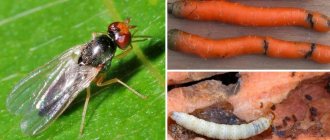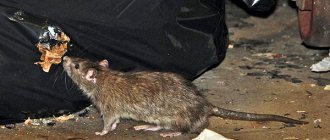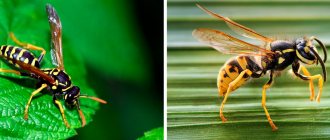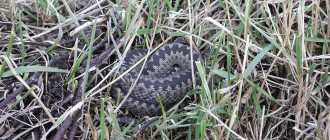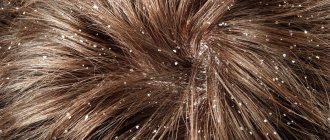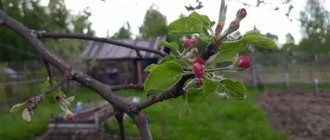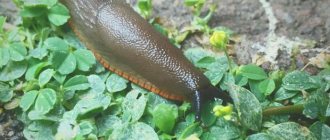Appearance and feeding habits of the apple blossom beetle
The flower beetle is a small brown insect with a long downward curved proboscis on which antennae are located. The adult size is only about 4 mm. There are two transverse stripes on the elytra that distinguish the insect from other species. The beetle has wings that make it very mobile. This affects its spread throughout the garden.
The feeding characteristics of the apple blossom beetle are that it devours inflorescences, which prevents the formation of the ovary. In addition to apple trees, the weevil affects raspberries and pears.
With the onset of spring warmth (about +5 degrees), the flower beetle moves to the trees and waits for the flowering period. Before this, it overwinters in the folds of tree bark or fallen leaves. The insect makes indentations in the kidneys from which juice is secreted. At the same time, it lays eggs to produce offspring. The larvae that hatch inside the flower begin to eat it from the inside, thereby causing the inflorescences to wither and dry out.
Description of the pest
The apple blossom beetle is a beetle from the weevil family.
It is classified as a monophage - creatures that feed on only one type of food. As a rule, the insect is found mainly on an apple tree, and extremely rarely on a pear.
The adult is a dark brown beetle with a body length of 3 to 5 mm, covered with fine gray hairs. Its elytra are light or dark brown-red, with a light oblique stripe in the upper part.
The pest's head is elongated. The rostrum is noticeable in the anterior part (in females it is longer), which is why the beetle belongs to the division of long-proboscis weevils. The proboscis ends in a mouth. The head has club-shaped, cranked antennae.
The limbs of the flower beetle are reddish, the front part of the thigh has one large tooth, and the back part has one small tooth.
Females lay watery-white eggs measuring 0.5–0.9 mm, up to 100 eggs per season. Yellow larva with a dark brown head 6 mm long. It is curved, narrowed at the back, and has no limbs. The back is dotted with wrinkles and tubercles.
The pupa is also yellow. Outwardly, it resembles an adult beetle, but with weak rudiments of a proboscis, limbs, and wings. Two spines grow at the end of the abdomen; several tubercles can be seen in the area of the pronotum above the head.
Life cycle of an insect
In early spring, at a stable air temperature of about +6-8 degrees, adult apple weevils, which were hiding in fallen leaves or tree bark, wake up. When the first buds and flower buds appear, females begin to lay eggs inside. After just a few days, larvae emerge from them and feed on the petals, pistils and stamens of the flower. At this point, the fruit can no longer form, and the inflorescence itself turns brown and becomes sticky from the secretions of the larva. The larva lives from 9 to 11 days, after which it turns into a sexually mature individual, ready for reproduction. It has been established that only 20 female weevils are needed to almost completely destroy the harvest from an entire tree.
Apple flower beetle - photo, description, lifestyle
The apple flower beetle (also known as the apple weevil or apple weevil) is a small beetle from the Weevil family. Like the vast majority of its “relatives” from this family, it feeds on plant tissues at different stages of its development, causing great harm to a variety of agricultural crops. Specifically, the apple flower beetle, as the name suggests, specializes in apple trees, and much less often affects pears and hawthorn.
These bugs overwinter in fallen leaves, in the top layer of soil, in cracks in the bark, and with the onset of the very first warm days they wake up and begin their harmful activities.
A comfortable awakening temperature for the apple blossom beetle is about 5-6°C, and with stable readings of about 10°C, insects are already active in large numbers in your garden - that’s why it’s so important not to miss the moment and take action in time. These brown bugs, 3-5 mm in size, have a sharp curved proboscis, with which they pierce swelling flower and leaf buds, as well as buds and suck out the juice from them
It is not difficult to notice the presence of a beetle - droplets of clear liquid appear on the kidneys in places of punctures, the so-called “crying kidneys”
These brown bugs, 3-5 mm in size, have a sharp curved proboscis, with which they pierce swelling flower and leaf buds, as well as buds, and suck out the juice from them. It is not difficult to notice the presence of a beetle - droplets of clear liquid appear on the kidneys in places of punctures, the so-called “crying kidneys”.
A little later, the time of reproduction comes - the female gnaws a small hole in the flower bud and lays an egg, placing it between the stamens. One female flower beetle damages at least 40-60 buds! The beetle lays the bulk of its eggs in April, but due to warming in recent years, the dates may shift to much earlier dates.
Whitish, legless, dark-headed larvae (thick “worms” 5-6 mm long), hatching from eggs about a week after laying, gnaw out the contents of the buds and fill them with waste, “gluing” them together from the inside.
Unopened buds dry out, forming brown caps, under which the larvae hide, and then the pupae that develop from them. A new generation of beetles, waiting until the chitinous cover gets stronger, gets out from under the cap and feeds on the young leaves of the apple tree, gnawing small holes in them, then settles throughout the garden.
The mass emergence of the apple weevil usually occurs in May; by the end of June, the beetles retreat into cracks in the bark for summer rest, and after the leaves fall, they hide for the winter.
During periods of mass outbreaks of reproduction (20-40 beetles per tree), the apple flower beetle can cause significant damage to fruit trees and the death of the entire crop. Particularly great damage from the weevil is felt in years with weak flowering of the apple tree; in this case, the apple harvest may not be expected.
What does an affected tree look like?
The first sign of a tree being damaged by the apple blossom beetle is buds that do not open in time. The affected areas are easy to notice against the background of a green plant. They have an unpleasant brown color and extremely painful appearance. Also, affected kidneys may secrete juice, this is especially noticeable in sunny weather. At the same time, if you look closely at the affected part of the tree, you will notice a small hole through which the beetle laid eggs.
At the end of the flowering period, flower beetle weevils can gnaw on the foliage, leaving characteristic openwork holes. If you ignore the damage to a tree, you may be left without a harvest, since insects multiply quite quickly and infest the entire garden.
Preparations for flower beetle on apple trees
The weevil can cause significant damage to fruit trees. He often leaves all the gardeners in the area without an apple harvest. Therefore, methods of combating the apple blossom beetle using folk remedies cannot cope with the invasion of this beetle completely. And here chemical weevil control agents can come to the rescue. Adult beetles should be destroyed during the period of bud break on the trees. After harvesting, re-treatment should be carried out, which will reduce the number of flower beetles before they go to winter.
How to treat apple trees against flower beetle?
If you are interested in how to deal with the flower beetle on an apple tree, then you should know that there are several effective insecticides for this:
- Karbofos, its 10% solution is used for spraying trees;
- Decis is available in 2 ml ampoules, which are diluted in a bucket of water.
- Kinmiks solution is prepared from a 2.5 ml ampoule of the drug and 10 liters of water;
- The universal drug Iskra double effect is available in tablets, one dose dissolved in 10 liters of water is enough for 2-4 trees, depending on age.
When to spray apple trees against flower beetle?
It is very important to treat fruit trees against apple blossom beetle in a timely manner. This bud break period does not last long, only 5-7 days.
And if you do not have time to spray the apple trees exactly at this time, then later your efforts will not have the expected effect. Experts recommend alternating chemicals to combat this pest: this year, for example, use Decis, a remedy for the apple blossom beetle, and next year, Karbofos or Kinmiks.
How to get rid of an insect
In a short period of time, the beetle can cause great damage to garden crops, so it is important to begin fighting it when the first signs of damage are detected. Unfortunately, this is quite difficult to do without modern chemicals, but it is possible. How to fight apple blossom beetle using folk methods? You can try the following methods:
- Collecting insects by hand. The technology is reminiscent of collecting Colorado potato beetles - early in the morning, before the beetles have time to hide inside the buds, you should collect them with your hands into a bucket filled with salt water. This method works, but it cannot significantly reduce the weevil population. Many of them hide in the bark or on branches.
- Lubricating the trunk and branches with lime mortar. Whitewashing on trees prevents insects from climbing up the tree from the ground, but it is harmless to those who have already settled on the plant.
- Shaking is done using wooden sticks wrapped in soft material, which need to be knocked on the trunk so that the beetles detach from the bark. First you need to lay a cloth under the tree in order to collect them. The apple blossom beetle can pretend to be dead and lie motionless for some time, but you must definitely burn all the collected insects.
These methods are used quite often, but chemical agents are considered the most effective.
Mechanical way of fighting
The simplest measures will help reduce the risk of beetle damage to the buds. So, it is necessary to regularly loosen the tree trunk circles, collect and destroy fallen leaves, and remove damaged and dry branches.
One of the most effective methods is shaking off insects from branches, after which they are destroyed. A film is spread underneath the crown, preventing pests from spreading throughout the area. It is better to carry out the work in the spring, when the beetle emerges from the state of winter dormancy (temperature 6...10 °C). The optimal time for such work is morning. Before flowering, the crown is cleaned at least three times.
Medicines against apple weevil
Chemicals are used to destroy the pest population. Spraying against apple blossom beetle is carried out during bud break or in the fall after harvesting. The most commonly used drugs are:
- "Fufanon", instructions for use, reviews of which indicate its high effectiveness. Used in an amount of 10 ml per 10 liters of water.
- "Calypso" is completely safe for bees, wasps and bumblebees. Diluted with water at the rate of 2 ml per 10 liters of liquid.
- "Kinmiks" is used not only against weevils, but also against other insects that feed on foliage. The concentration of the drug is 2.5 ml per 10 liters of water.
- "Tanrek" - does not wash off with water when it rains.
- The buds on the tree are sprayed with karbofos. It is used at the rate of 10% substance to 90% water.
- The drug "Decis", the instructions for use of which recommend a concentration of 10 ml per 10 liters of water.
- "Inta-Ts-M" - 1 tablet per bucket of water.
These drugs for apple blossom beetle can destroy the pest population with minimal damage to the plant. Gardeners especially note Fufanon in reviews, the instructions for use are simple and the cost is affordable. In addition, it has a wide spectrum of action and destroys not only the apple blossom beetle, but also other pests.
Prevention
- If the apple tree is young, pick off the first unopened flower with a brown cap and destroy the beetle larva . This is done with all brown buds.
- The trunks should be cleared of dead bark , which is the wintering site of the flower beetle.
- Place glue belts on the trunks of apple and pear trees to catch beetles crawling into the tree crown. After the apple trees bloom, the belts are removed and burned.
- Flower beetles weakly colonize fruiting apple trees, the crowns of which, at the beginning of bud swelling, are whitened with lime milk (1.5-2 kg of freshly slaked lime per 10 liters of water). But to attract beetles, one of the fruiting apple trees is left without whitewashing and only on it is the fight fought, shaking off the beetles.
- During the swelling and opening of the buds, shake off the beetles three or four times early in the morning onto any litter and then destroy them. Using wooden beaters or poles wrapped at the end with burlap or other soft material, so as not to damage the bark, they hit the skeletal branches sharply, but not forcefully. The beetles fall onto the litter, pretending to be dead. They are swept into a bucket of water, to which a little kerosene is added and destroyed.
Preventive measures
To prevent weevil damage to trees, the following popular methods are used:
- Applying a hunting belt - to do this, you need to twist a tight rope of fabric and apply it around the barrel. The material is coated with a special sweet sticky compound that attracts insects. When an insect sticks, it is important to remove it and destroy it.
- Before applying a layer of whitewash, you can clean the tree of old bark, in which beetles can hide. In this way, their population can be significantly reduced.
- In the fall, after the leaves fall, it is recommended to rake them into a pile and put them in a compost bin or burn them. The fact is that it is in fallen leaves that flower beetles can overwinter.
- After harvesting the leaves, you can dig up the soil.
- Affected buds and buds should be noticed and removed in time to prevent the pest from spreading further along the tree. This will greatly reduce the damage the beetle can cause and preserve most of your harvest.
This prevention is good for carrying out in the spring, before budding begins, or in the fall, after the leaves fall. Unfortunately, most methods are ineffective at the height of flowering.
Preventive actions
If you take preventive measures in a timely manner and keep your garden healthy, it is possible to avoid infection altogether.
These include:
- cleaning the bark and whitening it;
- cleaning the area under the tree and burning leaves;
- digging the tree trunk circle to pull hidden beetles out;
- spring preventive spraying and agrotechnical procedures.
Digging the trunk circle.
It is important to carry out these events twice: in spring and autumn.
How to spray a plant correctly
Most chemical preparations against the flower beetle are designed to be diluted with water in the proportions specified by the manufacturer and sprayed with a spray bottle.
How to spray garden plants correctly? The following recommendations must be followed:
- It is important to properly dilute the concentrate in water so as not to harm the tree. To do this, it is recommended to use measuring cups and instructions on the product label.
- Spraying is carried out after buds open, in dry, warm weather so that wind and rain do not prevent the drug from reaching the affected areas of the tree.
- Some substances are toxic to humans, so processing garden crops must be done with gloves and a protective mask. It is for this reason that it is important to spray at the flowering stage so that the insecticide does not get on the developing fruit.
- It is advisable to use a spray bottle with a long hose so that you can spray the top of the tree.
- It is advisable to spray the drug at a distance of at least 70 cm and no more than 90 cm from the foliage.
- Not only foliage and branches are subject to spraying, but also the trunk, as well as the ground around the tree.
The correct approach to spraying insecticide on plants will help eliminate pests as much as possible.
Chemicals
Treating the garden with chemicals is considered one of the most effective ways to combat harmful insects. There are a lot of drugs on the market that will help get rid of the beetle.
Expert opinion
Mityuk Stefania Bogdanovna
These drugs are ineffective against larvae. If an infection has occurred, then re-treatment with pesticides is carried out in July, before the adult individuals hide in the bark.
Aversectin S
The drug with this active substance is Fitoverm-M, CE. The product is produced only for use on an industrial scale. Aversectin C has a contact-intestinal mechanism of action. Treatment can be carried out shortly before harvest due to the short waiting period. Protection lasts up to 3 weeks.
Dimethoad
Preparations with active ingredients:
The active substance is absorbed by the plant after treatment with the solution, as a result of which the insects living on the plant die. The preparations are used to spray apple trees before flowering. Consumption per hectare - 800–1000 l.
Imidacloprid
Preparations with active ingredients:
Imidacloprid affects the nervous system of the pest, causing paralysis, convulsions and death of the beetle. The effect is observed within 3 days after spraying. Protection lasts up to 4 weeks. The substance practically does not enter the fruits. The drug is also used with fungicides. Spray the trees before flowering. 2–5 liters of working solution are consumed per tree.
Lambda-cyhalothrin
Substance-based products:
Lambda-cyhalothrin disrupts the functioning of the apple blossom beetle's nervous system and affects the motor centers. Death occurs within a day after the trees are treated. The disadvantage of this component is the long waiting period (up to 40 days). The product is compatible with most insecticides and fungicides, and can be used in tank mixtures. The preparations are used for spraying plants before flowering, consumption - 800–1200 l/ha.
Thiacloprid
The following drugs are produced based on thiacloprid:
The active component causes paralysis and convulsions, which is why the pest dies. The treatment is carried out during the period of bud release, the consumption per hectare is 600–1000 liters of the finished solution.
Tiametomxam
Based on the substance, the drug Aktara, VDG, KS are produced. The component affects insects that live secretly and feed on the lower part of the leaf blade. The protective effect lasts up to 4 weeks. Spraying with the drug is carried out before flowering. From 800 to 1200 liters of the finished product are poured onto one hectare of garden.
Complex wrestling
In order to truly protect the orchard, you need to take a responsible approach to insect control. The best effect can be achieved by using a set of methods, which consists of agrotechnical and chemical control, as well as prevention.
At the same time, in order to minimize the risk of damaging the tree by spraying, experienced gardeners recommend selecting complex chemical agents that act not only on the apple blossom beetle, but also on other harmful insects.
Maliciousness
The apple blossom beetle damages apple trees and sometimes pears. It causes the main damage by eating flowers. In new intensive gardens, crop losses due to flower beetle can reach up to 40%, in old industrial gardens and summer cottages - up to 80%.
The economic threshold of harmfulness is considered to be 0.5 beetles per 2 linear meters of branches in intensive gardens and 8 beetles per 2 linear meters of branches in old-type gardens. With such or greater population, combating the apple flower beetle is economically feasible.
Selection of apple tree varieties resistant to flower beetle
All varieties of apple trees can be divided into several types: weakly resistant, moderately resistant, highly resistant, immune. Gardeners recommend paying attention to the last 2 types if there is no time, desire or opportunity to deal with fruit pests.
Among them are the following varieties: Soyuz, Fairy, Rodnichok, Vasilisa, Palitra, Talisman, Linda, Red Poppy, Prima, Aphrodite, Red Amber. They are highly resistant not only to beetles, but also to many common diseases of fruit trees.
By effectively combining the right varieties of apple trees with decent care and timely processing, you can get a large and tasty harvest.
Folk remedies
Folk remedies have a less pronounced effect on the pest. However, they are popular among summer residents. Their use does not cause fear of being poisoned by pesticides or harming the environment.
Mechanical method
Those who want to get an environmentally friendly, organic harvest resort to safe means of pest control. One such method is the use of a catch belt. Such a trap is easy to make with your own hands from simple materials. The device is a strip about 25 cm wide made of cardboard, rags, straw, polyethylene, rubber or burlap, which is attached to the trunk. After pupation, the insect crawls out of the ground and, moving along the trunk, falls into a trap.
There are belts:
- Dry . The belt material is not processed in any way.
- Poisonous . Fabric or other absorbent material is treated with an insecticide and covered with a film on top to retain moisture.
- Sticky . Kraft paper is used to make the belt. An adhesive substance is applied to it on the outside, to which the pest sticks.
According to the design of the belt there are:
- Funnel-shaped . The material is attached to the top of the trunk, forming a bell with the wide part directed downward.
- In the form of a gate . Designed for insects that descend to hide in the soil. The trap is a rubber belt tied to the trunk at a height of 50 cm, with bent edges that seem to form a collar (cup). Vegetable oil is poured inside - the substance does not allow the beetle to get out.
- Double-sided funnel . This is a design that does not let insects in either down or up.
Herbal solutions
Gardeners use preparations from various plants and laundry soap to protect against apple weevil.
Here are some recipes:
Wormwood infusion
400 g of dry or 1 kg of fresh wormwood is poured into 10 liters of water, left for 24 hours, then boiled for another 30 minutes. Add 1/3 of a bar of soap to the filtered liquid.
Chamomile infusion
150 inflorescences are poured into 10 liters of water and left for a day. The liquid is filtered, ½ part of a briquette of laundry soap is added.
Onion peel
A 3 liter glass jar is filled with 1 liter of onion peel and 2 liters of water. The infusion is kept for 2 days and filtered. Add 50 g of laundry soap to the liquid. Before spraying the crowns, dilute the product with 10 parts of water.
Summer residents' experience
Finally, a few more tips from experienced gardeners.
“When one of our neighbors in the country gets an apple blossom beetle, we fight the problem collectively.
Prepare a mixture of the following components:
- copper sulfate - 50 g;
- urea - 700 g;
- water - 10 l.
We spray the crown and trunks with this mixture one day - each in its own area. It is important to carry out the treatment before the buds bloom on the tree.”
Which method of dealing with apple blossom beetle would you choose?
FolkChemical
Irina, Rostov
“If the problem is long-standing, I recommend this method. It is necessary to clear the trunk and lower branches of the bark - flower beetles overwinter in these parts of the apple tree. The garbage is burned. Then the trees need to be whitewashed with lime and trap belts placed on the trunk.”
— Irina, Rostov
Mikhail, Ryazan
“In my garden, the apple blossom beetle literally destroyed the entire crop. I tried many products, but Fufanon turned out to be the most effective. After treatment with this drug, the weevil affects only some flowers. I process the crown at 19-20 hours, I choose windless, dry weather. You need to make sure it doesn't rain the next day either. I tried to carry out the treatment during the day, but the effect was less.”
— Mikhail, Ryazan
Protecting your garden from the apple blossom beetle is not as difficult as it seems. In addition to the means and measures described, do not forget about prevention. Autumn whitewashing of trunks and cleaning the trunk circles of weeds will protect trees from pests.
When is the best time to treat apple trees against the flower beetle?
The main pest control measures are carried out in the spring, but some preventive measures can also be carried out in the fall. You should definitely collect and burn fallen leaves from under the trees. A number of pests that have fallen from the tree along with the leaves may be hiding under them. The ground under the apple tree needs to be dug up.
The fight against the flower beetle is not an easy task, requiring time, labor and material costs
Therefore, it is important not to bring the garden to a critical state, but to engage in prevention, containing the pest population at a “safe” threshold.
. I'm looking for a way to PARADISE.
At the time when the swelling and buds on the apple trees are swelling, it is very useful to shake off the flower beetles onto a special bedding that is placed under the crown. Using wooden mallets or poles wrapped in soft material to prevent damage to the bark, lightly strike the main branches of the tree. The beetles detach from the shock and fall onto the litter, where they lie for some time, pretending to be dead. They are burned along with the litter or swept into a special container for destruction. This operation should be carried out at an air temperature below 10 °C, otherwise the beetles will have time to fly away.
Tatiana Pavlyushchik
Varieties with an average flowering period are damaged more than others by weevils. For apple trees that bloom earlier, the most dangerous period for damage occurs at a time when the beetles are not yet ready to lay eggs. And in late-flowering varieties - when the eggs have already been laid. Particularly massive invasions of weevils occur in those gardens that are located close to shelter belts or forested areas. I agree with Evelina, fruit trees need to be treated three times. but once the fruit is set, pesticides are harmful. because they can absorb them.Fighting the apple blossom beetlebio-spark - 0.003 l.With the onset of summer, these structures can be removed.
Raisa Lazebnaya
The best effect can be achieved if you do not use the same drug every year, but alternate it with another effective drug. In gardens where trees are constantly treated against flower beetles, pests do not cause damage to the crop.
If the crowns of an apple tree are whitened with lime mortar, flower beetles will not populate them.
Processing in different regions
The first spraying of apple trees in different areas does not occur at the same time due to the characteristics of their climate. The following factors will indicate the need for the procedure:
- lack of snow;
- not yet swollen buds;
- air temperature from +4 to 5 °C.
The second treatment is performed when the temperature reaches +15 °C. As a rule, this occurs 2 weeks after the first spraying. At this time, a green cone appears (bud swelling occurs). In the future, measures related to the elimination of the flower beetle are carried out upon the formation of buds and after harvesting.
Apple blossom beetle (Anthonomus pomorum)
Pest type
Series: Coleoptera – Coleoptera
Family: weevils – Curculionidae
Found everywhere. Damages the apple tree.
The beetle is 3.5-5 mm in size, dark brown, covered with fine gray hairs; in the lower part of the elytra there is a scythe of light, a transverse stripe with a clear dark border; rostrum long, dark, slightly concave; geniculate antennae and legs are black-brown. The egg is oblong, watery-white, 0.5-0.8 mm long. The larva is 5-6 mm in size, curved, legless, yellow-white, tapering towards the posterior end, with a small dark brown head. The pupa is 4-6 mm, pale yellow, with two spines at the end of the abdomen.
Immature beetles overwinter in crevices and cracks in the bark, in the soil near the root collar at a depth of 2-3 cm, under fallen leaves. The emergence of beetles from wintering sites begins at an average daily temperature of 6 °C. At 8-10 °C there is a massive colonization of trees and active feeding of beetles. During the blossoming of fruit buds, mating occurs. During the period when the apple tree inflorescences are exposed and before the buds loosen, eggs are actively laid. When laying eggs, the female prefers the buds of the peripheral part of the tree crown, which increases the harmfulness, since this part of the crown produces high-quality fruits. The female gnaws a hole in the bud and lays an egg, placing it between the stamens. The hole is covered by plugs of excrement. Depending on the weather and the speed of development of the buds, egg laying lasts approximately 10-20 days.
Fertility – 50-100 eggs. After 4-8 days, the larvae are reborn and complete their development in 15-20 days, passing through three instars. The larvae pupate there, inside the damaged bud.
The development of the pupa at a temperature of 15-18 °C lasts 9-11 days, at a temperature of 20-22 °C - 8 days. The formed beetles stay inside the bud until the integument hardens, then they gnaw a hole in the cap from the dried petals and come out. A massive emergence of beetles is observed 8-12 days after the end of flowering, approximately in the third ten days of May. Over the course of 20-25 days, the beetles gnaw out small cankers on the fruits and skeletonize the leaves. In mid-summer, with the onset of dry and hot weather, they hide in cracks and crevices of the bark and branch branches. In autumn, the beetles move to their wintering grounds.
They develop everywhere in one generation. The damage is caused by beetles and larvae. Damage to the kidneys is especially dangerous in early spring, when beetles gnaw deep holes in them that resemble pricks. The larvae feed on the stamens and pistils, gnaw out the receptacle, and glue the petals from the inside. The bud does not bloom, they turn brown and dry out. The apple blossom beetle is especially harmful in years with cold springs, when the budding period lasts more than 20 days and the beetles have time to lay a significant number of eggs. The pest is also dangerous in years with poor flowering.
Protective measures. Autumn cleaning of dead bark for bedding and burning it. Autumn tillage between rows and tree trunks. In small gardens, early in the morning (at temperatures below +10 ° C) - shaking the beetles onto the bedding and then destroying them. If there are more than 40 beetles per tree, spray the trees with insecticides before the formation of buds.
Fire: control measures
The larvae emerge within a week and completely eat up the flower bud. Adult beetles gnaw leaves and damage the ovary. At the beginning of autumn, pests hide under the bark and spend the winter there. Flower beetles can destroy a significant part of the crop, so it is imperative to fight them.
Plucking drying buds on low fruit trees will also be useful in the fight against flower beetle. The removed buds are not destroyed, but placed in a jar without a bottom or a sieve, covered with gauze and placed in a well-ventilated place. When the larvae in the buds pupate, the containers are covered with dense material. By the time the young beetles emerge, the pumples - their parasites, insects resembling a wasp - will also fly out at the same time. They have transparent wings and a brown body. The pumps are very mobile, and when the covering material is removed they immediately fly out into the garden. After this, the remaining weevils should be destroyed.
In the fall, it is imperative to collect and burn leaves that have fallen from trees, and dig up the soil in the garden. Sometimes such a simple method of combating the flower beetle is used: special piles of leaves are laid out near the trunks, attracting pests for the winter, and after some time they are burned along with the beetles that have climbed there.
Damage to fruit trees by the flower beetle is especially dangerous in cold springs, when the flowering of trees is delayed, as well as in years of weak flowering of apple trees. In these cases, the apple blossom beetle is capable of destroying more than half of all buds, significantly reducing the harvest.
Flower beetle (weevil): control and prevention
The apple flower beetle damages the buds of the apple tree. Spraying trees during the period from bud opening to exposure of buds helps; during the transition of beetles from wintering areas to the crown before females lay eggs, one of the pesticides is used: chlorophos at a concentration of 0.2% (20 g per 10 liters of water), 0.1% th sevin, 0.15% phosphamide, 0.15% trichlorometaphos-3, metaphos at a concentration of 0.3%.
All this is diluted into one liter of water and the infected tree is sprayed.
You can also use another method of fighting the moth. This is high hilling. But this method is the most labor-intensive to use.
decis-pro – 0.0005 kg,
Prevention of damage
Very often, fruit trees and bushes are susceptible to various diseases, as well as pests. The main garden pests: flower beetle, moth, apple moth. Let's take a closer look at what effective methods of dealing with them exist.
Apple flower beetles have few natural enemies. They are eaten in small quantities by small birds. Pests also die from parasitic wasps, the females of which implant their eggs in the larvae of the flower beetle.
In the spring, when the beetles crawl out of their secluded places after hibernation, you need to immediately take steps to save the future harvest. You can destroy pests without chemicals. You cannot completely get rid of all pests using safe methods, but their number can be significantly reduced.
Spring is not only the time of awakening of plants, but also of garden pests. To preserve the harvest on fruit trees, it is necessary to take measures in early spring to combat the most common garden pest - the apple blossom beetle.
Fighting weevil
If, after shaking off, there are 40 or more beetles under the tree, it is necessary to spray the plant with insecticides: Intavir, Kinmiks, or others designed to destroy leaf-eating insects. It can also be treated with Tanrek, which is not washed off with water and acts over a wide temperature range. To combat weevils, it is recommended to do one treatment per season.
Preventive measures aimed against plant damage by the flower beetle should begin long before the buds open. First of all, you should clean the tree trunks from the remains of dead bark, which serves as a convenient place for pests to overwinter. This operation allows you to destroy a significant number of beetles that have settled down to wait out the cold season. But such cleaning should be done literally with the first warm days, otherwise the pest will have time to leave its shelters.
The flower beetle is a beetle of the weevil family, brownish-gray in color with oblique white stripes on the elytra, up to 0.45 cm in size, with a head elongated into a long proboscis. At the end of such a proboscis there is a special gnawing apparatus for feeding on leaves and buds. This voracious pest is widespread throughout the entire Non-Black Earth zone. But it causes the greatest harm in the northern regions, where effective control of the flower beetle becomes especially necessary. This pest damages apple, pear and other fruit trees.
In an integrated garden protection system, the need for spraying is determined not by the number of pests, but by the strength of the tree’s flowering. With abundant flowering, up to 15% of the remaining ovaries from the total number of flowers will give a full harvest. In this case, extermination measures may not be carried out. With weak flowering, it is necessary to fight the weevil.
Additionally, it is necessary to carry out annual cleaning, collection and destruction of bark that dries out, that is, dies.
Also, you need to remember that it is very important to dig up the soil in the fall.. The codling moth is a caterpillar that eats apple fruits
One such pest can eat up to four apples. Fruits damaged by the codling moth fall off and rot.
The codling moth is a caterpillar that eats apple fruits. One such pest can eat up to four apples. Fruits damaged by the codling moth fall off and rot.
indasad.ru
Iskra M – 0.01 l.
How to protect a site from apple blossom beetles?
It is always much easier to prevent pests than to get rid of them.
There are simple measures that will help you protect your area from weevils:
- removing loose bark from apple trees and lubricating the exposed area with a lime mixture. It is behind the bark that apple flower beetles hide to survive the winter; if it is removed, it will be more difficult for pests to find a place to overwinter;
- timely removal of leaves, weeds, branches, burning of all garbage. If the beetles are not hiding in the bark, then they are hiding under the leaves, so the areas around the apple trees need to be cleaned;
- digging up a piece of land around an apple tree. Such work will be useful for the apple tree itself, and will also help to get rid of pests hiding in the ground.
It is better to carry out all of the above work in the fall.
The apple blossom beetle is a beetle that primarily harms fruit trees. If you want to protect your garden from this pest, then do not forget about preventive measures; if the apple flower beetle has already settled on the site, then the tips listed above will help you get rid of the insects.


